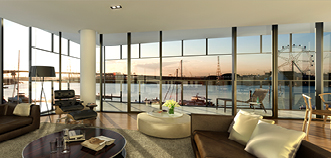Why design or build a green residential building?

![]()
The benefits of building green homes
The benefits of green buildings continue to stack up. Designing or building a green residential building delivers a range of benefits including:
Healthier homesGreen homes are healthy homes. Focused on good ventilation and indoor environment quality, low-toxic materials and abundant daylight, these factors have been proven to improve the health and wellbeing of residents.
|
|
Smart Investments
Evidence is emerging that building green rating translates into a higher sale price when it comes time to sell.
- Energy Efficiency rating and house price in the ACT (2008) examined the relationship between energy efficiency and house prices, finding that each half-star increase in the energy efficiency rating translated into a 2% increase in capital value.
- The Value of Green Labels (2012) found that higher returns are not restricted to the commercial market. A pricing analysis of all 1.6 million single-family home sales in California from 2007-2012 found that while the average sales price of a non-certified California home was $400,000, a green certification lifted the price by more than $34,800. This translated into a 9% green premium.
It is clear that sustainable buildings like Convesso represent smart financial investments today and environmentally responsible investments in our future.Hugh Martin, Executive Director, Lend Lease |
 |
|
|
||
|
With a 4 Star Green Star rating, Convesso 8 Waterside Place in Melbourne uses 65% less heating and cooling energy than similar sized, non-green apartments. It’s also a smart investment. |
||
 |
 |
 |
![]()
Reduced environmental impact
Did you know buildings are the single largest contributor to the world’s greenhouse gas emissions, using 40% of global energy and generating around 30% of the carbon emissions? By choosing to own green building you can easily reduce your impact of the environment.
The Value of Green Star: A decade of environmental benefits (2013) finds that, on average, Green Star-certified buildings:
- Use 66% less electricity than average Australian buildings
- Produce 62% fewer greenhouse gas emissions than average Australian buildings
- Use 51% less potable water than average buildings
- Recycle 96% of their waste, compared with 58% for the average new construction project.

|
The Redfern Housing Redevelopment in Sydney features water-efficient fittings and fixtures, as well as the reuse of rainwater and treated greywater, which are saving 4,700 cubic metres of water a year – the equivalent of two Olympic-sized swimming pools or 33,571 bathtubs. The cost savings amount to $7,500 a year across the entire tenancy. |
 |
![]()
 |
Market recognitionIncreasingly green buildings are perceived as industry leaders and organisations associated with green buildings benefit from these perceptions through:
|
|
|
||
|
The Green Star-rated Melbourne Convention and Exhibition Centre not only set a new global standard for convention centre design - the MCEC’s innovation and ingenuity has led to more than $1 billion of economic activity for Victoria, as well as acknowledgement with dozens of awards, including the 2010 Victorian Architecture Medal. Read the Melbourne Convention and Exhibition Centre case study. |
 |
|
 |
 |
|
| Ready to start using Green Star? Green Star – Multi Unit Residential v1 Green Star – Communities Green Star – Interiors More Green Star rating tools |
 |
Contact:
Jorge Chapa
Chief Impact Officer
Green Building Council of Australia
Phone: 02 8239 6218
Email: jorge.chapa@gbca.org.au
In this section
- Why design or build a green commercial building?
- Why design or build a green residential building?
- Why design or build a green school?
- Why design or build a green hospital?
- Why design or build a green public building?
- Why own a green commercial building?
- Why own a green residential building?
- Why own a green school?
- Why own a green hospital?
- Why own a green public building?


